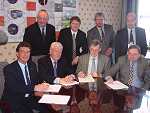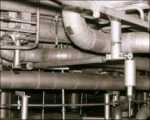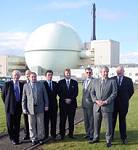|
Caithness.org News Bulletins |
||
| Dounreay News Index | Caithness.org News Index | Front Page Archives |
|
UKAEA announces Decommissioning Alliance For
Dounreay Fast Reactor 12 February 2002
Bob Mathews, Head of Decommissioning outlined the development and progress up out he signing of today's contract with the Alliance formed to carry out the pioneering work of decommissioning the Fast Reactor site.
UKAEA site director Peter Welsh said: "This is a milestone in the site restoration plan. When this alliance finishes its task, we will have successfully completed the first and most crucial stage of decommissioning a reactor that represents one of the major engineering and environmental challenges on this site." Mr Welsh added that there were more opportunities for local training providers and Thurso College as part of the University of the Highlands to run courses.
"Before we can dismantle the primary circuit, we must drain the remaining NaK and begin cutting out the breeder fuel, " explained Bob Mathews, UKAEA's head of decommissioning at Dounreay. "We plan to remove and destroy the bulk of the NaK during 2004-05 and expect to announce shortly a separate alliance to remove the breeder fuel, so today's announcement is a major plank in our overall strategy."
Approximately £10 million of the contract value is expected to go to locally-based companies, with an initial 50 jobs created or retained locally. A key feature of the alliance will be the transfer of specialist skills, such as robotics, from major contractors to local firms. This will improve their ability to compete for future decommissioning work at Dounreay and elsewhere in the world. The cutting and removal of the labyrinth of pipes that carried the radioactive NaK coolant within the heavily shielded concrete vault must be carried out remotely because of the levels of radiation present. Remotely operated vehicles, working in a temperature of minus 18 degrees Celsius to eliminate the risk of ignition in the NaK-wetted circuits, will lay their own working platforms before cutting sections of pipework into pieces that will be removed for cleaning and disposal. Notes UKAEA estimates it will take until 2013-2022 to complete the removal and destruction of the NaK, decommissioning of the DFR fuel pond, removal of the breeder fuel, and the removal and cleaning of the NaK-wetted primary circuits, at a cost in the region of £173 million. The total estimated cost of decommissioning DFR by 2026-2042 is in the region of £250 million. Some 1500 activities required to decommission Dounreay over a 50-60 year period at a cost in the region of £4 billion are contained in the Dounreay Site Restoration Plan, which can be viewed at www.ukaea.org.uk |
||





